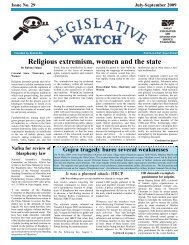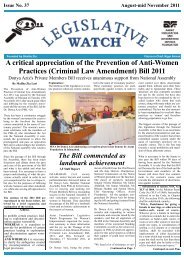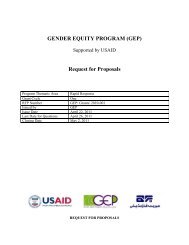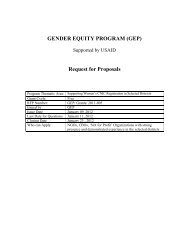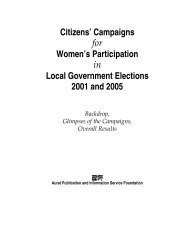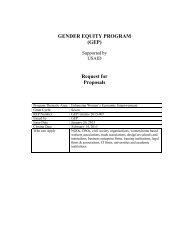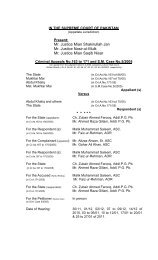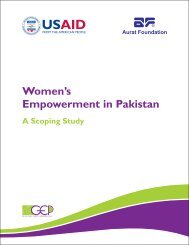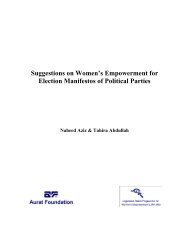Legislative Quotas for Women: A global and ... - Aurat Foundation
Legislative Quotas for Women: A global and ... - Aurat Foundation
Legislative Quotas for Women: A global and ... - Aurat Foundation
- No tags were found...
Create successful ePaper yourself
Turn your PDF publications into a flip-book with our unique Google optimized e-Paper software.
22 Serbia 5 2012 250 81 32.4% --- --- --- ---23 Ecuador 4 2009 124 40 32.3% --- --- --- ---- Timor-Leste 6 2007 65 21 32.3% --- --- --- ---24 New Zeal<strong>and</strong> 11 2011 121 39 32.2% --- --- --- ---- Slovenia 12 2011 90 29 32.2% 11 2007 40 1 2.5%25 Belarus 9 2008 110 35 31.8% 7 2008 58 19 32.8%26 Algeria 5 2012 462 146 31.6% 12 2009 136 7 5.1%27 Guyana 11 2011 67 21 31.3% --- --- --- ---The F.Y.R of28Macedonia6 2011 123 38 30.9% --- --- --- ---29 Burundi 7 2010 105 32 30.5% 7 2010 41 19 46.3%The data in the table above has been compiled by the Inter-Parliamentary Union on thebasis of in<strong>for</strong>mation provided by National Parliaments by 31 May 2012.* Figures correspond to the number of seats currently filled in ParliamentIntroduction of special measuresThough women’s under-representation in politics is not a newphenomenon, but with the maturity of women rights movement today weare witnessing a growing impatience with the very slow rate of change inthis regard.Gender quotas which are being introduced in a growing number ofcountries are in response to this growing impatience <strong>and</strong> represent a shiftfrom the old concept of equality to a newer one. The classic liberal ideaof equality was a notion of "equal opportunity" or "competitive equality"that called <strong>for</strong> removing the <strong>for</strong>mal barriers, <strong>for</strong> example, giving womenvoting rights. The rest was up to the individual women.However, following strong pressure from the women rights groups duringthe last few decades, which is evident <strong>for</strong> instance in the Beijing"Plat<strong>for</strong>m <strong>for</strong> Action" of 1995, a second concept of equality has beengaining increasing relevance <strong>and</strong> support: the concept of "equality ofresult". What is meant by it is that real equal opportunities do not existjust because <strong>for</strong>mal barriers are removed. Besides direct discrimination, acomplex pattern of hidden barriers prevent women from being selected asc<strong>and</strong>idates <strong>and</strong> getting their share of political influence. Thus quotas <strong>and</strong>other <strong>for</strong>ms of positive measures are a means towards equality of result.The basis of this argument is the experience that equality as a goal cannotbe reached by <strong>for</strong>mal equal treatment as a means. Wherever barriers exist,13



